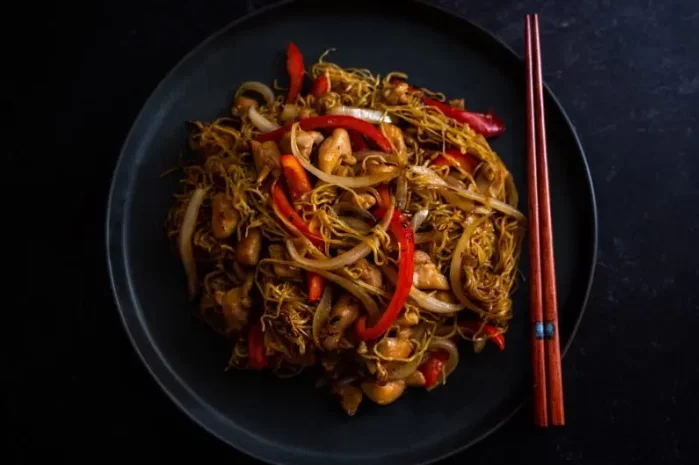Szechuan sauce, also spelled Sichuan or Szechwan sauce, is a vibrant and fiery condiment that hails from the Sichuan province in southwestern China. This region is famed for its bold, spicy cuisine, which stands out for its ability to balance intense heat with complex, nuanced flavors. The origins of Szechuan sauce are deeply rooted in the culinary traditions of Sichuan, a province known for its humid climate, which has influenced the local palate’s preference for hot and spicy foods. This affinity for spice is not just about flavor; it’s a practical response to the need for food preservation and the stimulation of appetite in the region’s damp conditions.
At the heart of Szechuan sauce is a blend of key ingredients that define its distinctive flavor. The most notable of these is the Sichuan peppercorn, which is not actually a pepper but a dried husk of a seed. This ingredient imparts a unique numbing and tingling sensation, known as “málà” (麻辣), a characteristic that sets Sichuan cuisine apart from other regional Chinese cuisines. Alongside Sichuan peppercorns, the sauce typically includes dried red chilies, garlic, ginger, soy sauce, vinegar, and sugar. The combination of these ingredients creates a sauce that is simultaneously spicy, tangy, and slightly sweet, with layers of flavor that unfold with each bite.
SEE ALSO: What Chinese Food Has Water Chestnuts?
Key Ingredients:
The primary ingredients of Szechuan sauce include Sichuan peppercorns, dried red chilies, garlic, ginger, soy sauce, vinegar, and sugar. Some variations might also include doubanjiang (fermented broad bean paste) and sesame oil, adding depth and complexity to the flavor.
Flavor Profile:
Szechuan sauce is renowned for its complex flavor profile, which is both spicy and tangy. The heat primarily comes from red chilies, while the Sichuan peppercorns create a tingling, numbing sensation on the palate. The sauce is also balanced with sweet and sour notes, making it versatile for a variety of dishes.
Types of Szechuan Sauce:
Prepared vs. Homemade: Prepared Szechuan sauce is readily available in stores, offering convenience with a consistent flavor. Homemade versions allow for customization, where the balance of ingredients can be adjusted according to personal preference.
Spiciness Levels: The level of spiciness in Szechuan sauce can vary widely. Some versions focus more on the numbing effect of the Sichuan peppercorn, while others emphasize the fiery heat of the chilies.
Classic Dishes:
Kung Pao Chicken: A popular Szechuan dish where the sauce brings out the flavors of tender chicken, peanuts, and vegetables.
Mapo Tofu: A dish that pairs the fiery Szechuan sauce with silky tofu and minced pork, creating a rich and hearty meal.
Dan Dan Noodles: Szechuan sauce adds a spicy kick to these noodles, traditionally topped with minced pork and preserved vegetables.
Modern Interpretations:
Marinades and Glazes: Use Szechuan sauce as a marinade for meats or a glaze for grilled dishes, adding a unique spicy-sweet flavor.
Stir-Fries: Incorporate the sauce into stir-fries with vegetables, tofu, or meat for an extra layer of flavor.
Dips: Mix Szechuan sauce with mayonnaise or yogurt to create a spicy dip for snacks like spring rolls or dumplings.
Pairing Suggestions:
Tofu: The sauce enhances the blandness of tofu, making it a flavorful option for vegetarians.
Chicken and Seafood: Its robust flavor complements both chicken and seafood dishes.
Noodles and Vegetables: The sauce adds excitement to simple noodle dishes and stir-fried vegetables.
Usage Tips and Techniques
Adjusting Spice Level:
Reduce the number of dried chilies or Sichuan peppercorns.
Add more sugar or vinegar to balance the heat.
Dilute the sauce with broth or water for a milder taste.
Balancing Flavors:
Adding a touch of sugar to counteract the acidity and heat.
Using soy sauce for a salty umami flavor.
Incorporating vinegar for tanginess, which also cuts through the richness of the dish.
Serving Suggestions:
Side Dishes: Serve Szechuan sauce dishes with steamed rice or plain noodles to soak up the sauce.
Garnishes: Fresh cilantro, chopped green onions, or sesame seeds can be sprinkled on top to add freshness and texture.
Beverages: Pair these spicy dishes with a cooling drink like iced tea, beer, or a mild yogurt-based beverage.
Recipe Ideas
Beginner-Friendly Recipes:
Szechuan Stir-Fried Vegetables: A simple stir-fry with mixed vegetables and a generous drizzle of Szechuan sauce.
Spicy Szechuan Noodles: Quick and easy noodles tossed in Szechuan sauce, perfect for a fast meal.
Intermediate and Advanced Recipes:
Mapo Tofu: A more complex dish involving multiple steps, perfect for those looking to master Szechuan cooking.
Szechuan Chicken: A dish that requires marinating, stir-frying, and glazing with Sal cuisine.
Conclusion
Szechuan sauce is more than just a condiment; it is a culinary expression of Sichuan’s rich heritage and a testament to the region’s love for bold and intense flavors. With its roots deeply embedded in the history and culture of southwestern China, Szechuan sauce has become a symbol of the province’s distinctive culinary identity. The sauce’s complex flavor profile, marked by its unique combination of spiciness, tanginess, and the numbing sensation of Sichuan peppercorns, makes it a beloved ingredient not only in traditional Chinese dishes but also in modern global cuisine.
Realted Topics:


























